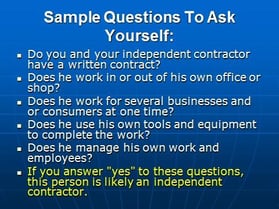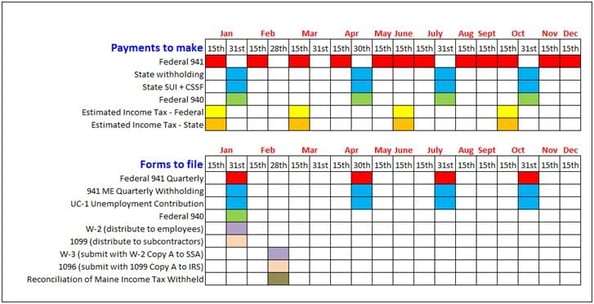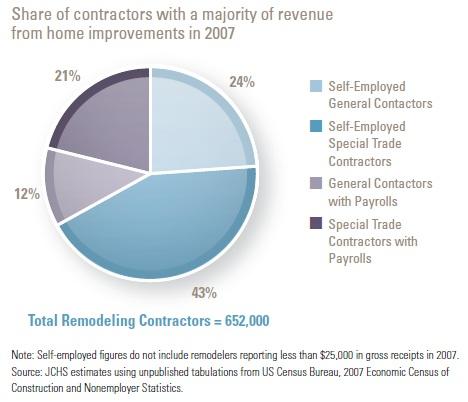Think Twice Before You Use Subs or 1099’s Who Can’t Speak English; Here’s 2 Simple Reasons Why
 The government has recently been cracking down on improper classification of workers as subcontractors. Understanding the difference, at least in the eyes of the government, can help a remodeler avoid challenges as well as the fines and penalties that come with misclassification. I recently became aware of an additional consideration as a result of reading an article in Remodeling magazine titled “Se Habla Ingles + No = No Deal? Get Real!” After reading the article, but particularly the reader comments, that new consideration jumped out at me. Using subcontractors and or 1099 workers who do not speak English can put your remodeling business at risk in at least two costly ways.
The government has recently been cracking down on improper classification of workers as subcontractors. Understanding the difference, at least in the eyes of the government, can help a remodeler avoid challenges as well as the fines and penalties that come with misclassification. I recently became aware of an additional consideration as a result of reading an article in Remodeling magazine titled “Se Habla Ingles + No = No Deal? Get Real!” After reading the article, but particularly the reader comments, that new consideration jumped out at me. Using subcontractors and or 1099 workers who do not speak English can put your remodeling business at risk in at least two costly ways.
Two simple ways the language barrier can put your remodeling or construction business at risk
#1: Customer service can be compromised leading to loss of repeat work and referrals.
Let’s face facts here; if a worker cannot speak English there will definitely be communication challenges. This is clearly demonstrated by the comment left at the article I mentioned above. The comment was by Perry, an actual consumer who personally experienced the challenges and disappointments caused both by the workers who could not adequately understand English as well as the business that hired them:
“It's difficult to quantify or fully explain in this comment the magnitude of problems we've had on our current job, but approximately half the problems can be traced directly back to a communication problem with the workers at the site. I witnessed our job supervisor explaining what was needed (in as good a Spanish as he could muster), the worker acknowledging his understanding, and hours later when the completed work is inspected, it's clear the worker did not understand exactly what was needed. This has happened repeatedly, with some of the mistakes far more costly than others.”
 When a customer experiences what Perry speaks to its not likely the contractor performing the work will ever get future business or referrals from the disappointed customer. Remember, quality is not just determined by the final outcome. Quality is also determined by the experience the consumer has as the product is being delivered.
When a customer experiences what Perry speaks to its not likely the contractor performing the work will ever get future business or referrals from the disappointed customer. Remember, quality is not just determined by the final outcome. Quality is also determined by the experience the consumer has as the product is being delivered.
#2: Risk of the government deciding they are employees
Contractors should be using fixed scope contracts with subcontractors. Subcontractor agreements should detail the work to be completed, the expected outcome, when it has to be completed and include a fixed price for the services performed. If a subcontractor and or his/her workers cannot read a written work order due to a language barrier someone outside the subcontractor’s business will have to explain what is to be done and how it is to be done to the subcontractor. And in the absence of the subcontractor at the jobsite someone will need to explain and direct that sub’s employees. This type of relationship with a sub and or the sub’s employees demonstrates control by the business that hired the subcontractor.

The IRS will consider a worker to be an employee unless independent contractor status is clearly indicated by the relationship between the worker and a remodeling business. The way the IRS sees it an employee is a worker who performs services at the direction of an employer. Subcontractors are considered to be in business for themselves and work under their own direction. So simply stated anyone who performs services for a remodeler is an employee if the remodeler can and or does control what will be done and how it will be done. Explaining things to a worker and orally directing how and in what order to perform their work therefore makes the worker an employee.
The fines and penalties for misclassification can ruin your business
As I pointed out in a previous blog post the determination by the government of misclassification of workers can be caused by many reasons. Plus when it happens the government assumes you to be guilty until you prove your innocence. If you cannot create a written subcontractor agreement, in the  language of the subs you work with which details the scope of work they are to perform independently, you and or your business will be forced to orally direct the work of the subs. Once you do that the government no longer classifies them as subs, but rather as employees. That is therefore misclassification. According to an article at workcompcentral, in Tennessee a company by the name of Aguilar Carpentry was caught misclassifying workers and was fined $73,000. In another article posted to WTNH.com a CT contractor was fined $20,240 for misclassification. Those fine amounts would put most remodelers out of business.
language of the subs you work with which details the scope of work they are to perform independently, you and or your business will be forced to orally direct the work of the subs. Once you do that the government no longer classifies them as subs, but rather as employees. That is therefore misclassification. According to an article at workcompcentral, in Tennessee a company by the name of Aguilar Carpentry was caught misclassifying workers and was fined $73,000. In another article posted to WTNH.com a CT contractor was fined $20,240 for misclassification. Those fine amounts would put most remodelers out of business.
Still unsure about your relationship with sub? Here are three possible options
For a quick answer perhaps just take the quiz Remodeling Magazine recently offered titled: "Take the Quiz: Are You Misclassifying Your Subcontractor?" Answer the questions honestly and then see if the government would call them subs or employees.
 If you want help from the IRS and you have a lot of time to wait you can use IRS Form SS-8, Determination of Worker Status for Purposes of Federal Employment Taxes and Income Tax Withholding. The completed form can be filed with the IRS by either the business or the worker. The IRS will review the facts and circumstances and officially determine the worker’s status. Unfortunately it can take at least six months to get a determination. Additionally, often times because determining factors used by the government are not always objective, the determination may not binding.
If you want help from the IRS and you have a lot of time to wait you can use IRS Form SS-8, Determination of Worker Status for Purposes of Federal Employment Taxes and Income Tax Withholding. The completed form can be filed with the IRS by either the business or the worker. The IRS will review the facts and circumstances and officially determine the worker’s status. Unfortunately it can take at least six months to get a determination. Additionally, often times because determining factors used by the government are not always objective, the determination may not binding.


 Many contractors are using what are refer to as 1099 workers to avoid employee and payroll related administrative responsibilities and financial costs. Some use this tactic to reduce their costs to help win bids and or make more money. If you never get caught you may feel or believe it was worth it. On the other hand if you get caught, whether you knew what you were doing was illegal or you really believed what you were doing was OK, the financial and litigation related costs can kill your business. The chance of this happening has dramatically increased in certain areas of the country because Washington is offering money to states to help them do so. Read on to find out about what is already happening in Virginia.
Many contractors are using what are refer to as 1099 workers to avoid employee and payroll related administrative responsibilities and financial costs. Some use this tactic to reduce their costs to help win bids and or make more money. If you never get caught you may feel or believe it was worth it. On the other hand if you get caught, whether you knew what you were doing was illegal or you really believed what you were doing was OK, the financial and litigation related costs can kill your business. The chance of this happening has dramatically increased in certain areas of the country because Washington is offering money to states to help them do so. Read on to find out about what is already happening in Virginia. That means you have to pay up on any fines, at their full rate (anywhere from $7K to 70K per violation) right away. Then you have to decide if you are willing to wait for your legal case to make it through a legal system sponsored by the same entity that is accusing your business.
That means you have to pay up on any fines, at their full rate (anywhere from $7K to 70K per violation) right away. Then you have to decide if you are willing to wait for your legal case to make it through a legal system sponsored by the same entity that is accusing your business.
 Payroll is complicated enough without having to worry about when to make payments and when to file which form to which government entity. I have many clients who are comfortable creating paychecks, but are nervous about missing payroll tax payments or filing forms late. A client recently asked if I couldn’t find a simple way to have reminders that would prompt him to do whatever had to be done. To help I created a simple “in your face” payroll reminder.
Payroll is complicated enough without having to worry about when to make payments and when to file which form to which government entity. I have many clients who are comfortable creating paychecks, but are nervous about missing payroll tax payments or filing forms late. A client recently asked if I couldn’t find a simple way to have reminders that would prompt him to do whatever had to be done. To help I created a simple “in your face” payroll reminder.
 How to get it on your desktop
How to get it on your desktop

 It would appear that in the original interview ProSales had with Lowes about the story the fact that Lowes was selling 2x4’s that did not meet the standard accepted size of 1 ½” x 3 ½” was a detail left out of the interview. I say this with a high level of confidence because I find ProSales to be consistently accurate and the magazine editor, Craig Webb, does a great job vetting the information being published.
It would appear that in the original interview ProSales had with Lowes about the story the fact that Lowes was selling 2x4’s that did not meet the standard accepted size of 1 ½” x 3 ½” was a detail left out of the interview. I say this with a high level of confidence because I find ProSales to be consistently accurate and the magazine editor, Craig Webb, does a great job vetting the information being published.  The concern I am expressing is if these rules apply to retailers will they also apply to contractors? If they do, or eventually will, contractors in California and the rest of the country may also run into challenges not only with the government, but also with their customers. Perhaps trade associations such as NAHB and NARI should proactively seek out the answer to this question to help guide and protect their members and the rest of the construction industry. The RRP Rule came about because our industry didn’t proactively deal with the hazards of lead during construction on its own before the government stepped in and dictated regulations many do not agree with.
The concern I am expressing is if these rules apply to retailers will they also apply to contractors? If they do, or eventually will, contractors in California and the rest of the country may also run into challenges not only with the government, but also with their customers. Perhaps trade associations such as NAHB and NARI should proactively seek out the answer to this question to help guide and protect their members and the rest of the construction industry. The RRP Rule came about because our industry didn’t proactively deal with the hazards of lead during construction on its own before the government stepped in and dictated regulations many do not agree with. 
 It would appear to anyone who knows and understands how lumber is graded and sold that the state of California is looking for ways to fine legitimate businesses, even if those businesses are conducting business using traditional and industry accepted methods and terminology.
It would appear to anyone who knows and understands how lumber is graded and sold that the state of California is looking for ways to fine legitimate businesses, even if those businesses are conducting business using traditional and industry accepted methods and terminology.  Will you have to describe the actual dimensions of every framing product you specify in your next proposal, including the actual thickness of sheet goods?
Will you have to describe the actual dimensions of every framing product you specify in your next proposal, including the actual thickness of sheet goods?
 The letter will also notify the contractors that EPA will be inspecting a number of them in June 2014. According to the press release EPA lead inspectors will inspect numerous renovation, painting and property management companies in the New Haven area regarding their compliance with the RRP Rule. The inspections may be followed up with enforcement.
The letter will also notify the contractors that EPA will be inspecting a number of them in June 2014. According to the press release EPA lead inspectors will inspect numerous renovation, painting and property management companies in the New Haven area regarding their compliance with the RRP Rule. The inspections may be followed up with enforcement. Time will tell whether this intuitive will help improve compliance in any significant way and or really have any effect on leveling the playing field. Either way it’s likely that EPA will use the findings and enforcement of this initiative to capture the attention of contractors in the New Haven area. Contractors outside of CT may also want to consider that this may be a test program that could eventually be put in place in other areas of the country.
Time will tell whether this intuitive will help improve compliance in any significant way and or really have any effect on leveling the playing field. Either way it’s likely that EPA will use the findings and enforcement of this initiative to capture the attention of contractors in the New Haven area. Contractors outside of CT may also want to consider that this may be a test program that could eventually be put in place in other areas of the country.
 One employee was found using a table saw without using safety glasses. This offense came with a $1200 fine. The inspector noted the violation was corrected during inspection.
One employee was found using a table saw without using safety glasses. This offense came with a $1200 fine. The inspector noted the violation was corrected during inspection. Mark shared that his first experience with OSHA was back in 1979 when working as a project supervisor. An OSHA inspector showed up at the job site with three books under his arm. Mark said the inspector greeted him with; “You’re going to get a fine today. I’ve got three books here and I’m sure I can find something in one of them”.
Mark shared that his first experience with OSHA was back in 1979 when working as a project supervisor. An OSHA inspector showed up at the job site with three books under his arm. Mark said the inspector greeted him with; “You’re going to get a fine today. I’ve got three books here and I’m sure I can find something in one of them”. 
 Fast delivery of that one joist hanger you’re missing so you can put the floor sheathing down and get the wall framing going
Fast delivery of that one joist hanger you’re missing so you can put the floor sheathing down and get the wall framing going I first came across this topic in a
I first came across this topic in a 
 The details: He uses his own tools and performs services in the order designated by the corporation and according to its specifications. The corporation supplies all materials, makes frequent inspections of his work, pays him on a piecework basis, and carries workers' compensation insurance on him. He does not have a place of business or hold himself out to perform similar services for others. Either party can end the services at any time.
The details: He uses his own tools and performs services in the order designated by the corporation and according to its specifications. The corporation supplies all materials, makes frequent inspections of his work, pays him on a piecework basis, and carries workers' compensation insurance on him. He does not have a place of business or hold himself out to perform similar services for others. Either party can end the services at any time. The details: A signed contract established a flat amount for the services rendered by Bill Plum. Bill is a licensed roofer and carries workers' compensation and liability insurance under the business name, Plum Roofing. He hires his own roofers who are treated as employees for federal employment tax purposes. If there is a problem with the roofing work, Plum Roofing is responsible for paying for any repairs.
The details: A signed contract established a flat amount for the services rendered by Bill Plum. Bill is a licensed roofer and carries workers' compensation and liability insurance under the business name, Plum Roofing. He hires his own roofers who are treated as employees for federal employment tax purposes. If there is a problem with the roofing work, Plum Roofing is responsible for paying for any repairs.
 I hope by sharing this information, those who are in favor of protecting children from the dangers of lead due to renovations will make it a strategic priority to hold EPA accountable to rethink the practicality of the rule. Hold them accountable to establishing and using objective metrics that measure EPA and the rule's performance. And, most importantly, to make sure if performance objectives are not achieved those responsible for those objectives will be identified and removed from their positions. The health and well-being of our nation's children are too important to tolerate the kind of performance the EPA has demonstrated to date. If you agree, make sure you speak to your political representatives and get their commitment to hold EPA accountable.
I hope by sharing this information, those who are in favor of protecting children from the dangers of lead due to renovations will make it a strategic priority to hold EPA accountable to rethink the practicality of the rule. Hold them accountable to establishing and using objective metrics that measure EPA and the rule's performance. And, most importantly, to make sure if performance objectives are not achieved those responsible for those objectives will be identified and removed from their positions. The health and well-being of our nation's children are too important to tolerate the kind of performance the EPA has demonstrated to date. If you agree, make sure you speak to your political representatives and get their commitment to hold EPA accountable. On an early 2012 webinar with EPA Officials Regarding RRP public awareness and enforcement efforts hosted by NCHH, I asked EPA officials if they were doing any tracking to check the actual effectiveness of their outreach efforts. They were not.
On an early 2012 webinar with EPA Officials Regarding RRP public awareness and enforcement efforts hosted by NCHH, I asked EPA officials if they were doing any tracking to check the actual effectiveness of their outreach efforts. They were not. 
 EPA does not know how many children were actually poisoned by RRP activities before the rule came into effect.
EPA does not know how many children were actually poisoned by RRP activities before the rule came into effect.





